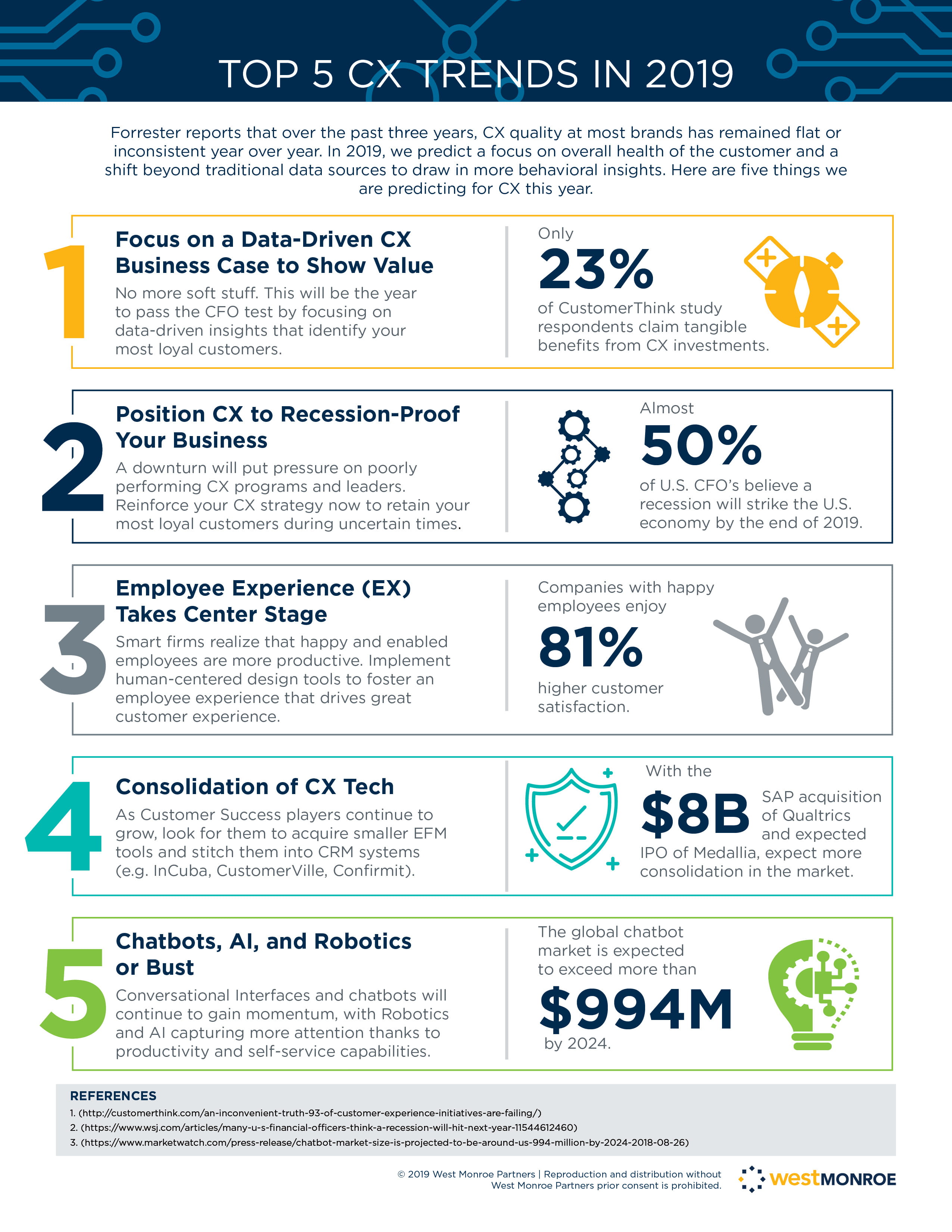
Feb. 8, 2019 | InBrief
5 key trends for customer experience executives in 2019
5 key trends for customer experience executives in 2019
New Year, New CX?
Happy 2019! As customer experience (CX) professionals, 2019 is a critical year to demonstrate and articulate the tangible benefits and value of CX in our organizations. Here are five key CX trends that we believe organizations and their CX executives will focus on this year.
Trend #1: Demonstrating and articulating the value that CX executives bring to the organization
The buzz is growing around the topic “Is CX starting to circle the drain?” We discussed this very topic during one of our podcast episodes last year, “Is CX in danger of dying?” 2019 will be the ”show me” year for CX executives. Much of this comes down to the difficulties of quantifying and articulating the business value that CX can deliver. CX executives must work with their business partners to obtain the data required to measure and quantify the value they deliver within the organization. CX leaders will be successful by connecting customer experience and employee experience metrics to operational metrics, ultimately tying to business outcomes (think Balanced Scorecard). Without clear results, leadership and boards will reduce or no longer fund ongoing CX initiatives, placing the budget (and employment) of CX executives at risk.
Trend #2: Determining how CX can help organizations recession-proof their business
WARNING: we are NOT economists. While much of the United States saw continued economic growth in 2018 (with historically low unemployment rates) and expect continued growth (albeit, at a slower pace), we are 10 years past the Great Recession and beyond the typical 7-year economic cycle. Some economists and business leaders have predicted a recession in the near future, but possibly not until 2020.
With any sort of economic downturn, companies will look for ways to “tighten-the-belt” and identify areas within the business to reduce investment to ensure survival. CX is no exception on the list of potential investments to get cut, especially with Trend #1 as an issue for CX executives. However, this is the perfect time for organizations to invest in CX to ensure they are growing their base of loyal customers. This is important because those loyal customers will continue to spend their money with your organization, even when they have less to spend. On the other hand, organizations that do not have a great CX have a greater risk of customers choosing to take their limited financial resources elsewhere.
While organizations want to be considered “CX Leaders” within their industries (nearly 89% of companies, per Forrester), true CX leaders will use this time to double-down on CX as a way to maintain, and ultimately accelerate, growth coming through the next economic down-turn.
Trend #3: Continuing to improve the employee experience
As previously mentioned, 2018 saw historically-low unemployment rates, creating a fierce talent war for companies looking to hire and retain their best employees. Last year, we saw a concentrated effort to improve employees’ experience to address this challenge. Employees carry their own expectations as customers in the workplace and are critical in delivering an exceptional experience to your customers. Organizations are now battling to retain their best employees. Additionally, we’ve seen the symbiotic relationship between a good employee experience (EX) and its impact on delivering a good customer experience (CX). Improving EX, just like improving CX, requires some level of investment (which could be at risk, as previously discussed). However, CX leading organizations understand two key points:
- Employee experience is another way to double-down on and improve CX to continue to deliver business results
- Customer experience and employee experience is as much of a human-centered mindset and approach as it is about investment in technology, new products, and other improvement initiatives, and doesn’t always require large capital investments
Trend #4: Consolidating of, investing in, and integrating of “CX Tech” and other various Voice of the Customer (VoC) and Experience Management (XM) platforms
We saw this trend kick-off at the end of 2018, with both the $8 billion (yes, billion with a “B”) acquisition of Qualtrics by SAP and the merging of ForeSee and Verint. Additionally, Medallia (considered one of the top platforms in the CXM platform space, according to Forrester) appears to be preparing for a public offering (IPO) in 2019. This newly available financial capital will not only fuel features and capability maturation, but will also drive a massive up-tick in market presence, which will benefit CX leaders.
On a related note, this will further highlight the importance of customer data within the organization. The Qualtrics acquisition alone demonstrates the immediate need and importance of bringing together customers’ transactional, behavioral, and sentiment data into a single view (CRM 3.0?). When you pair this with business analytics, you’re able to understand the totality of the customers’ relationships with your organization and operationalize this data in a way that employees can consume and take action on to deliver a better experience. We anticipate customer success players like Gainsight, Totango and Strikedeck to play a role in this consolidation as vendors battle over customer and employee data.
Trend #5: Experimenting and investing in emerging technologies to deliver a more seamless experience
Organizations will continue to identify key business opportunities to deliver new value to customers and employees through the maturation of new technologies. This includes looking at new ways to engage customers through conversational interfaces, smart assistants, and increasing productivity and self-service through Artificial Intelligence (AI) and Robotic Process Automation (RPA). Additionally, organizations will look at opportunities to disrupt existing business models and value chains by embracing Blockchain. We discuss this topic in a previous episode of our “This Is CX” podcast. However, it is key that CX leaders are part of this work, so they can bring in CX tools to ensure the customers’ voices are heard and understood and not lost with the excitement of new technology.
2019: The “Show Me” Year
Given where businesses are, 2019 should be another exciting AND challenging year for CX executives in their focus on becoming CX leaders in their respective markets. With the focus on delivering value to both customers and their business, CX executives should continue to build the customer-centered mindset to influence and drive new products and services, while focusing on gathering the required data to quantify the value that CX directly (or indirectly) delivers.
What are your biggest predictions for this year? We would love to hear your challenges as well as what you’re seeing, and we are of course here to help if you have any questions along the way.


